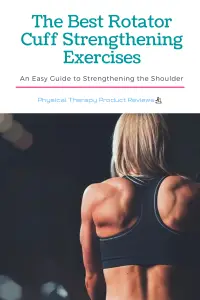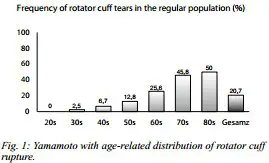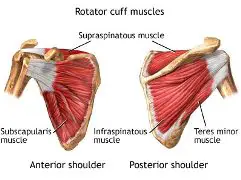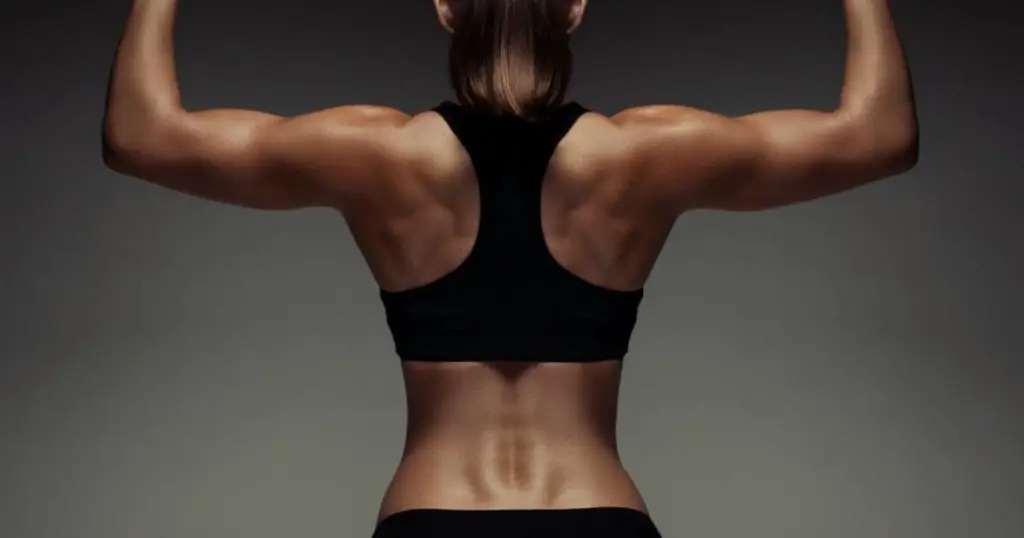The Best Rotator Cuff Strengthening Exercises
 Rotator cuff tears are one of the most common injuries to the shoulder and the incidence is rising. Overall, there was a 141% increase in the number of rotator cuff repairs performed within the last decade (1). You most likely know someone or have experienced first hand the pain and limitations that accompany a rotator cuff injury. Rotator cuff pain can severely limit your activities such as tucking in your shirt, reaching into the top cabinet, putting on your seat belt, or simply reaching out in front of you. There is often pain at night when trying to sleep, pain with washing your hair, and even simple tasks such as driving are no longer pain-free and easy to execute. Have you tried to go a whole day with the use of only one arm? It’s extremely difficult! One of the best ways to both prevent and help recover from a rotator cuff injury to strengthen the shoulder. This post will demonstrate the best rotator cuff strengthening exercises to do at home.
Rotator cuff tears are one of the most common injuries to the shoulder and the incidence is rising. Overall, there was a 141% increase in the number of rotator cuff repairs performed within the last decade (1). You most likely know someone or have experienced first hand the pain and limitations that accompany a rotator cuff injury. Rotator cuff pain can severely limit your activities such as tucking in your shirt, reaching into the top cabinet, putting on your seat belt, or simply reaching out in front of you. There is often pain at night when trying to sleep, pain with washing your hair, and even simple tasks such as driving are no longer pain-free and easy to execute. Have you tried to go a whole day with the use of only one arm? It’s extremely difficult! One of the best ways to both prevent and help recover from a rotator cuff injury to strengthen the shoulder. This post will demonstrate the best rotator cuff strengthening exercises to do at home.
How Common are Rotator Cuff Injuries?
The prevalence of a rotator cuff tear in each decade was 0-5% in the 20s to 40s, 10.7% in the 50s, 15.2% in the 60s, 26.5% in the 70s, and 36.6% in the 80s (2). Ultrasound scanning has demonstrated that 13% of the population in the fifth decade, 20% in the sixth decade and 31% in the seventh decade of life have a rotator cuff tear (3). Yamaguchi et al (4) demonstrated that more than half of asymptomatic rotator cuff tears will eventually continue to become symptomatic within 3 years. This makes it so much more important to protectively strengthen and slow down the progression of the asymptomatic tears before they becomes worse.
Prevalence of Rotator Cuff Tears

What is the Rotator Cuff?
The rotator cuff is a group of 4 muscles and their connecting tendons that work together to stabilize the shoulder. The general anatomy of the shoulder makes the joint more mobile and less stable due to the congruence when compared to other joints within the body. Therefore the shoulder is reliant on muscles, tendons, and ligaments to maintain stability through movement. That’s where the rotator cuff comes into play. In the simplest of terms, they work together to control the head of the shoulder during complex movements.
Supraspinatus
-
- Muscle inserts on told of the shoulder. Helps with lifting the arm
Infraspinatus
-
- Muscle on the backside of the shoulder and helps with backward rotation
Subscapularis
-
- Muscle on the front side of the shoulder that helps with forward rotation and attaches the shoulder to the shoulder blade
Teres Minor
-
- The smallest of the rotator cuff assists the Infraspinatus in backward rotation and stabilization of the shoulder
Muscles of the Rotator Cuff

Symptoms of a Rotator Cuff Injury
The symptoms of a rotator cuff will vary depending on the severity of the injury, location of the injury within that muscle, and also which of the 4 muscles are involved. A small tear in the Teres Minor will present much differently than a full tear of the Supraspinatus. Also there is a large difference in symptoms when there is an acute injury from a fall on an outstretched arm as compared with a long term wear and tear injury. With that being said there are some general common complaints that you should look for:
Chronic Degenerative Rotator Cuff Tears
- Pain at night, particularly when trying to sleep on the injured side
- Weakness or inability to raise your arm above your head
- Severe pain with palpation
- Inability to tuck in your shirt or reach behind your back
Acute or New Rotator Cuff Injury
- Increased swelling in the shoulder
- Inability to raise your arm above shoulder height
- Inability to lie on the side of injury
- Weakness rotating or reaching quickly
Risk Factors for a Rotator Cuff Tear
The risk factor for a rotator cuff tear within the general population are:
- Age – the more experienced at life you are the more likely you are to have a tear
- (Doesn’t mean you have to have surgery!)
- Being male or having a Y chromosome
- Injury being on the dominant arm
- Working in a heavy labor profession or an overhead sport
- Having a history of trauma
Do I need to have Rotator Cuff Surgery?
The short answer is no, it is not always. The size, location of the tear, and your age are all very important factors for surgery and something you should discuss with your physician. Small and medium tears may be fine after a good physical therapy program and time to heal. The longer and slower the tear progressed, the more likely that your body has been able to adjust and compensate appropriately. You may be what’s called a “coper” and would benefit most from getting stronger, hence the exercises below.
Physical therapy and rotator cuff strengthening programs have been shown to be as effective as surgery in certain cases. See link below:
http://www.apta.org/PTinMotion/NewsNow/2014/3/12/RotatorCuffTears/?blogid=10737418615
Rotator Cuff Tear Size and Re-tear Rate (5)
| Tear Size (cm2) | Re-tear Rate (%) |
| ≤2 | 10 |
| 2–4 | 16 |
| 4–6 | 31 |
| 6–8 | 50 |
| >8 | 57 |
This means even if you do have rotator cuff surgery, that if the original tear is greater than 4 cm in size the chances of re-tearing it is 30% or greater! So regardless, it is really important to try the conservative approach first and to maintain the strength if you have already had surgery. Here are the 6 best rotator cuff strengthening exercises.
6 Best Strengthening Exercises for a Rotator Cuff Injury
These are the 6 best exercises that you should perform if you have a rotator cuff tear. It is important to mention if you have pain with any of these obviously stop and don’t push it. Depending on how recent the injury occurred and the size of tear, you may not be able to perform all of these. Start with the first 3 exercises and then progress to the standing exercises as the pain and motion improves. The goal of these exercises are to hit most of the muscles involved with or have influence on the position of head of the shoulder (where the rotator cuff attaches) or the position of the shoulder blade.
If you need resistance bands check out our Best Rated Resistance Bands
Side Lying Shoulder External Rotation
This is the staple exercise that will show up when one searches for rotator cuff strengthening exercises but with a twist. Perform while lying on your side to fight gravity and to increase muscle activity of your shoulder blade stabilizers.
WHY: To strengthen the Insfraspinatus and Teres Minor while stabilizing the shoulder blade
What You Need:
Side Lying Shoulder Flexion
This exercise is much harder than it looks or sounds. Lie on your side with your hand starting on you hip. Bring your hand towards head in a horizontal plane. This make you fight gravity the whole time and is one of the best exercise to train the lower and mid-trapezius muscle while using less of the upper trap. Also breaks the bad habit of lifting the shoulder upward during arm elevation.
WHY: To strengthen the posterior shoulder and get the greater lower/mid trap versus upper trap activation
What You Need:
Prone Horizontal Abduction with External Rotation
Another exercise that is much more difficult than it sounds or looks. Start by lying on your stomach and rotating your arm so that your thumb is pointed towards the ceiling. Squeeze your shoulder blade down and towards your back pockets then raise your arm sideways toward the ceiling. Keep the thumb pointed towards the ceiling. This targets the posterior rotator cuff and shoulder blade stabilizers.
WHY: To stabilize the shoulder blade while strengthening the Rotator Cuff in a more difficult position
What You Need:
Serratus Punches
This is easily the most movement difficult exercise to master. Make sure to keep the elbows, wrist, and shoulders straight and don’t bend them during the exercise. The motion comes from the shoulder blades sliding around the ribcage and targeting a muscle called your Serratus Anterior.
WHY: To strengthen the muscle that helps control the upward rotation of the shoulder blade
What You Need:
Wall Walks with Y’s
This is an easy exercise to do just about anywhere and is emphasizing your shoulder blade tilting posterior thus allowing more room for the top of the rotator cuff tendon to move within the shoulder (subacromial space). Feel free to walk your hands higher on the wall if there is no pain than what they do in the video.
WHY: To strengthens multiple different muscles of the shoulder and shoulder blade including lower trap, Serratus Anterior, the Insfraspinatus and Teres Minor.
What You Need:
Exercise Ball 90/90 External Rotation
A killer upper body and shoulder exercise where form is really important. Balance on the ball while laying on your stomach. Keep your neck in neutral and start with your shoulders out at 90 degrees and the elbows bent at 90 degrees. Then squeeze the shoulder blades down and back towards the hips, and rotate yours shoulder up while maintaining the elbows and shoulders at 90 degrees.
WHY: Works the rotator cuff stability in a position away from the body. Targets the scapular stabilizers and the posterior rotator cuff.
What You Need:
Disclaimer: Always consult your physician before beginning any exercise routine. This is for informational purposes only.
Works Cited
- Colvin AC, Egorova N, Harrison AK, Moskowitz A, Flatow EL. National Trends in Rotator Cuff Repair. The Journal of Bone and Joint Surgery American volume. 2012;94(3):227-233. doi:10.2106/JBJS.J.00739.
- Minagawa H, Yamamoto N, Abe H, et al. Prevalence of symptomatic and asymptomatic rotator cuff tears in the general population: From mass-screening in one village. Journal of Orthopaedics. 2013;10(1):8-12. doi:10.1016/j.jor.2013.01.008.
- Tempelhof S, Rupp S, Seil R. Age-related prevalence of rotator cuff tears in asymptomatic shoulders. J Shoulder Elbow Surg 1999;8:296-9
- Yamaguchi K, Tetro AM, Blam O, et al. Natural history of asymptomatic rotator cuff tears: a longitudinal analysis of asymptomatic tears detected sonographically. J Shoulder Elbow Surg 2001;10:199-203.
- Wu, XL, Briggs, L, Murrell, GAC. Intraoperative determinants of rotator cuff repair integrity: an analysis of 500 consecutive repairs. Am J Sports Med. 2012;40(12):2771-2776
- YAMAMOTO, A., TAKAGISHI, K., OSAWA, T., et al.: Prevalence and risk factors of a rotator cuff tear in the general population. J. Shoulder Elbow Surg, 19: 116-120, 2010.
Disclaimer: The information provided in this post is for educational purposes only. This is not a substitute for a medical appointment. Please refer to your physician before starting any exercise program.







